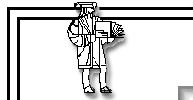 |
 |
|
Electrotype Fakes
The electrotyping process is a highly specialized variation of casting, invented as suitable batteries came available about 1850. At first an industrial process, the first electrotype copies of ancient coins appeared by the mid 1850's. The best are dangerous fakes but with one major flaw that is difficult to conceal and if not concealed they are easy to spot This YouTube video from the Metropolitan Museum shows an elaborate piece of art replicated through electrotyping, explaining the process better than I could in words. 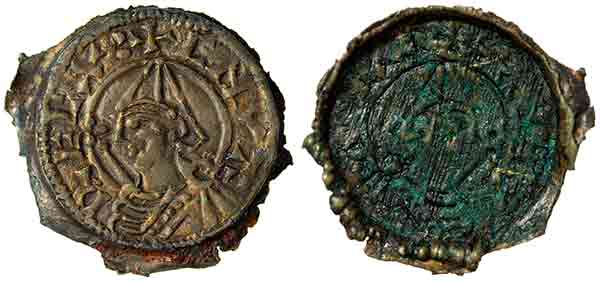
To copy a coin, each side of the coin must be copied independently. Here you see both sides of the shell for the obverse of a British Cnut penny. Note it is copper, hollow, with large flashings around the edge. 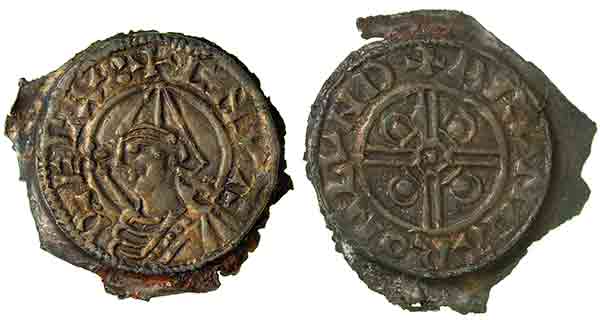
Seeing the obverse and reverse shells together gives an idea of the amount of work that would be involved to trim, filled, jointed and then silver plated this example turn it into an accurate representation of a genuine silver penny. 
The major flaw with electrotypes is the joint as seem on the Julia Soaemias bronze shown at the top of this page. The grey along the joint is solder joining the halves and possibly filling the hollow that would exist between them. All electrotypes have such a joint so are easy to spot as long as no one has worked the edge to hide it. The shells are usually electroplated of pure copper and very few ancient coins were struck of pure copper. Electrotypes have to be plated with the appropriate metal for the type copied, if they are to actually look like that type. Plating has its own problems and gives a surface that looks like that of an original ancient coin. Having to fill and join the shells makes weight control difficult. Electrotypes are never the same alloy is the coin being copied, even if a copper coin, as the void filler will be different. If you trim carefully to get the thickness right, without the correct alloy all the way through both the weight and specific gravity will probably be off. Few people walk around with equipment that can test specific gravity, but they do carry scales and while weight control is less critical for most bronze coins, it is for most silver and gold coins and seldom with the electrotypist get the weight that accurate. If someone has gone through the trouble to trim, fill, join and plate the coin, they can be a problem for buyers who have only seen an image of the coin that does not include the edge, and images of the edge of coins for sale in the internet are nearly never shown. 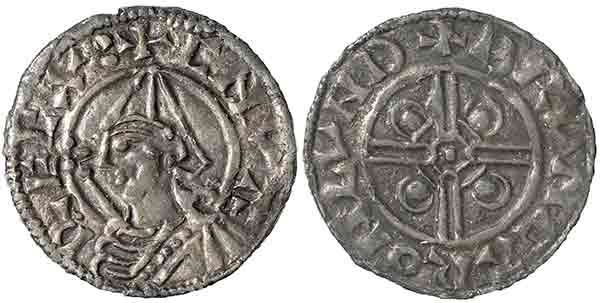
Here is that Cnut penny after I have digitally trimmed, silver plated and given it a nice old collection tone. Someone not having a high level of experience with Cnut pennies might buy this coin having only seen this image. Electrotyping is a sophisticated type of casting using a mold and so shares many of the problems and limitations common to all castings. The fineness of the mold medium determines the minimum size of details that can be copied, although very fine clays are easily obtained and the best electrotypes can capture details even finer than lost wax casting. What they cannot do is copy the in internal structure of flan cracks, nor can they reproduce luster. Clay is impervious to air, so air trapped while impressing the mold can result in features nearly identical to the casting bubbles discussed on the previous page. Tiny bits of clay may pull away with the original coin leaving small ragged depressions in the mold resulting in corresponding irregular bumps on the finished copy. 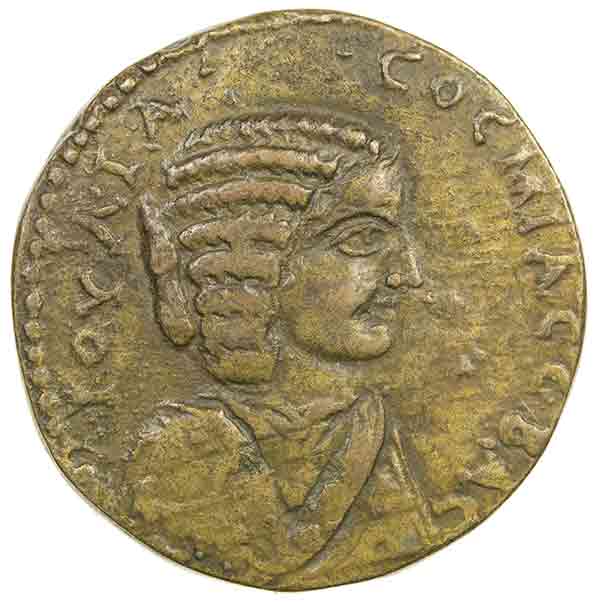
One can see the very fine details reproduced on this Julia Soaemias electrotype, but there are several casting bubbles visible with two just below the bust truncation, a small cluster surrounding the first letter of the inscription and several in her hair. Slightly larger irregular bumps can be seen in front of her mouth, which look as though a bit of clay pulled away from the mold, although those could be details of minor encrustation on the original coin. It can be difficult to tell the difference without the original available for examination, but either way they look like features that should not be visible as part of the surface on a genuine ancient coin.. In spite of these problems, a well done electrotype with its edge carefully worked to hide the joint and the whole coin given a false patina can be a modestly dangerous fakes. Electrotype fakes are seldom made today as they are far more labor intensive than a lost wax casting and the lost wax casting can be done in the correct metal of the coin being copied.. Most electrotypes were made more than a century ago, often by Robert Ready and his sons as official copies of coins, medals and seals for the British museum. Intended for displays and museum gift shop replicas there was no intend they should pass as genuine coins. The problem was others buying them as replicas, worked over the edge, applying a false patina, then attempting to pass them as genuine Early Robert Ready examples are not marked. Later he stamped them on the edge with his initials RR. As his sons came into the business many were stamped with only one R. Sometimes examples were made uniface and sold as obverse and reverse pairs. Learning to recognize electrotypes is useful not only to spot them when presented as originals, but because there are electrotype collectors and electrotypes can have value in their own right, especially if they can be attributed as the work of Robert Ready. There was a group of high quality fakes commonly known as the British Museum Forgeries. The British Museum had nothing to do with them, but the forgers created false dies from Robert Ready electrotypes because they could not get their hands on genuine examples of the very rare types. In my examples section I discuss a Katane tetradrachm which came on the market more recently, which is not part of the British Museum Forgery group but I believe was also struck from false dies created from a Robert Ready electrotype. Electrotyping can never produce a perfect fakeNext page: TOOLED FAKES Copyright © 2016 R & T Enterprises Ltd. |